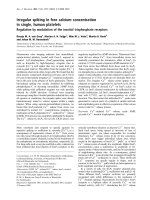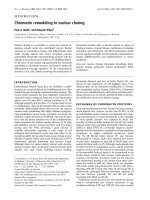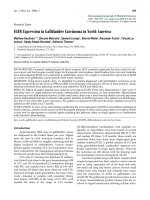Báo cáo y học: "Qualitative cultures in ventilator-associated pneumonia – can they be used with confidence" doc
Bạn đang xem bản rút gọn của tài liệu. Xem và tải ngay bản đầy đủ của tài liệu tại đây (32.85 KB, 2 trang )
425
VAP = ventilator-associated pneumonia.
Available online />Clinically, ventilator-associated pneumonia (VAP) is defined
by the presence of new or progressive radiographic infiltrates
plus clinical evidence that these infiltrates are of infectious
origin. The presence of an infiltrate plus at least two out of
three clinical features (abnormal temperature [> 38°C or
< 36°C], leucocytosis or leucopenia, and purulent secretions)
are the most accurate criteria for starting empirical antibiotic
therapy [1]. Although sensitivity for the diagnosis of
pneumonia is increased if only one criterion is used, this
occurs at expense of specificity, leading to significantly more
antibiotic treatment. Requiring all three clinical criteria is too
insensitive and will result in many patients with true
pneumonia not receiving therapy. Bacteriological
confirmation of VAP is important because many aetiologies
other than infection can cause the same clinical picture [2].
The ‘gold standard’ ultimately remains controversial, because
histological confirmation is very difficult and the criteria used
to define it are not uniform [2].
The aetiological cause of pneumonia can be defined by
semiquantitative cultures of tracheal aspirates or sputum.
Tracheal aspirate cultures consistently grow more micro-
organisms than do invasive quantitative cultures, and most
microbiology laboratories report the findings in a
semiquantitative manner. Confirmation of VAP is difficult;
confirmation of aetiology usually requires a lower respiratory
tract culture, including tracheal aspirate, bronchoalveolar
lavage, or protected specimen brush. Although an
aetiological diagnosis is made from a respiratory tract culture,
colonization of the trachea precedes development of
pneumonia in almost all cases of VAP, and therefore a
positive culture cannot always distinguish between pathogen
and a colonizing organism. However, a sterile culture from
the lower respiratory tract in an intubated patient, in the
absence of a recent change in antibiotic therapy, is strong
evidence that pneumonia is not present, and an
extrapulmonary site of infection should be considered [2,3].
Also, the absence of multiresistant micro-organisms from any
lower respiratory specimen in intubated patients, in the
absence of a change in antibiotics within the preceding
72 hours, is strong evidence that they are not the causative
pathogen. The time course of clearance of these difficult-to-
Commentary
Qualitative cultures in ventilator-associated pneumonia – can
they be used with confidence?
Carlos M Luna
1
and Alejandro Chirino
2
1
Associate Professor of Internal Medicine, Pulmonary Division, Hospital de Clínicas, Universidad de Buenos Aires, Argentina
2
Fellow, Pulmonary Division, Hospital de Clínicas, Universidad de Buenos Aires, Argentina
Corresponding author: Carlos M Luna,
Published online: 25 October 2004 Critical Care 2004, 8:425-426 (DOI 10.1186/cc2988)
This article is online at />© 2004 BioMed Central Ltd
Related to Research by Camargo et al., see page 513
Abstract
The sensitivity and specificity of the radiographic and clinical evidence used to diagnose ventilator-
associated pneumonia vary depending on the number of clinical criteria present. Bacteriological
confirmation that rules out other diseases can be achieved by quantitative or qualitative cultures of
tracheal aspirate. The rate of tracheal colonization in ventilated patients reduces the usefulness of
qualitative cultures, but the absence of multiresistant micro-organisms in cultures from patients on prior
antibiotics or a sterile culture in patients without prior antimicrobials may provide sufficient justification
to stop or de-escalate antibiotics. However, more accurate guidance regarding whether antibiotics are
unnecessary and should be stopped is provided by quantitative culture.
Keywords antibacterial agents, diagnostic techniques, microbiology, respiratory tract infections
426
Critical Care December 2004 Vol 8 No 6 Luna and Alejandro Chirino
treat micro-organisms is usually slow and so, even in the face
of a recent change in antibiotic therapy, sterile cultures may
indicate that these organisms are not present [4]. For these
reasons, a lower respiratory sample for culture should be
collected from all intubated patients when the diagnosis of
pneumonia is considered.
In this issue of Critical Care Camargo and coworkers [5]
report a prospective study in which they compared
quantitative versus qualitative cultures of tracheal aspirate in
patients with VAP. They conducted weekly surveillance in
severely ill, mechanically ventilated patients admitted to the
intensive care unit, performing sequential evaluations for the
diagnosis of VAP. In 97% of the evaluations, patients were
receiving antimicrobials. The authors evaluated tracheal
aspirates qualitatively and quantitatively, simultaneous with
expert evaluation. The experts’ evaluations yielded a
diagnosis of VAP in 38 assessments in 33 patients, and a
negative diagnosis in 181 evaluations performed in
73 patients (incidence of VAP 17.4%). In quantitative culture
evaluation, tracheal aspirate yielding ≥10
5
colony-forming
units/ml included 25 out of 38 cases of ‘true VAP’, resulting
in a sensitivity of 65.8% and a specificity of 48%. When
≥10
6
colony-forming units/ml was used as the cutoff point,
the sensitivity was 26% and specificity was 78%. With
regard to qualitative evaluation, the sensitivity was 81% but
specificity was only 23%. Camargo and coworkers
concluded that quantitative cultures of tracheal aspirates in
selected critically ill patients have decreased sensitivity as
compared with qualitative analysis, and should not replace
the latter for confirming a clinical diagnosis of VAP or to
guide adjustment to antimicrobial therapy.
The use of qualitative cultures has some associated
problems; the incidence of colonization is very high in
hospitalized patients in general, and even more so in patients
requiring endotracheal intubation [6]. It may be inappropriate
to base a decision to begin or to continue antibiotic
treatment for VAP on the results of qualitative cultures,
because positive qualitative culture findings may represent
simple colonization, and if this were the case then
antimicrobial therapy would be strongly discouraged.
The study by Camargo and coworkers confirms that it is
uncommon for a tracheal aspirate culture to yield no
pathogens, independently if such pathogens were found at
high concentrations in invasive quantitative cultures [2,7,8].
Qualitative cultures have their greatest value if they are
negative and the patient has not been receiving new
antibiotics within the preceding 72 hours. Negative lower
respiratory tract cultures in such patients can be used to
justify stopping antibiotic therapy.
We believe that the take-home message of the study is that a
negative qualitative culture from tracheal aspirate, in the
absence of prior antibiotics or a recent change in antibiotic
therapy, is sufficient evidence to discount a diagnosis of VAP
and therefore to stop antibiotic therapy. However, the
decision to maintain antibiotic administration guided only by
qualitative culture findings may lead to unnecessary antibiotic
use, leading to higher costs and encouraging bacterial
resistance. To do qualitative cultures is better than not to do
cultures, and if they are negative then this finding can safely
be used to justify discontinuing antimicrobial therapy.
However, quantitative cultures are preferable for making
decisions regarding therapy for VAP.
Competing interests
The author(s) declare that they have no competing interests.
References
1. Fabregas N, Ewig S, Torres A, El-Ebiary M, Ramirez J, de la Bella-
casa JP, Bauer T, Cabello H: Clinical diagnosis of ventilator
associated pneumonia revisited: comparative validation using
immediate post-mortem lung biopsies. Thorax 1999, 54:867-
873.
2. Kirtland SH, Corley DE, Winterbauer RH, Springmeyer SC, Casey
KR, Hampson NB, Dreis DF: The diagnosis of ventilator associ-
ated pneumonia. A comparision of histologic, microbiologic
and clinical criteria. Chest 1997, 112:445-457.
3. Souweine B, Veber B, Bedos JP, Gachot B, Dombret MC,
Regnier B, Wolff M: Diagnostic accuracy of protected speci-
men brush and bronchoalveolar lavage in nosocomial pneu-
monia: impact of previous antimicrobial treatments. Crit Care
Med 1998, 26:236-244.
4. Torres A, Ewig S: Diagnosing ventilator-associated pneumo-
nia. N Engl J Med 2004, 350:433-435.
5. Camargo LFA, De Marco FV, Barbas CSV, Hoelz C, Bueno MAS,
Rodrigues M Jr, Amado VM, Caserta R, Martino MDV, Pasternak J,
Knobel E: Ventilator associated pneumonia: comparison
between quantitative and qualitative cultures of tracheal aspi-
rates. Crit Care 2004, 8:R422-R430.
6. Niederman MS: Gram negative colonization of the respiratory
tract: pathogenesis and clinical consequences. Semin Respir
Infect 1990, 5:173-184.
7. Rumbak MJ, Bass RL: Tracheal aspirate correlates with pro-
tected specimen brush in long-term ventilated patients who
have clinical pneumonia. Chest 1994, 106:531-534.
8. Jourdain B, Novara A, Joly-Guillou ML, Dombret MC, Calvat S,
Trouillet JL, Gibert C, Chastre J: Role of quantitative cultures of
endotracheal aspirates in the diagnosis of nosocomial pneu-
monia. Am J Respir Crit Care Med 1995, 152:241-246.









